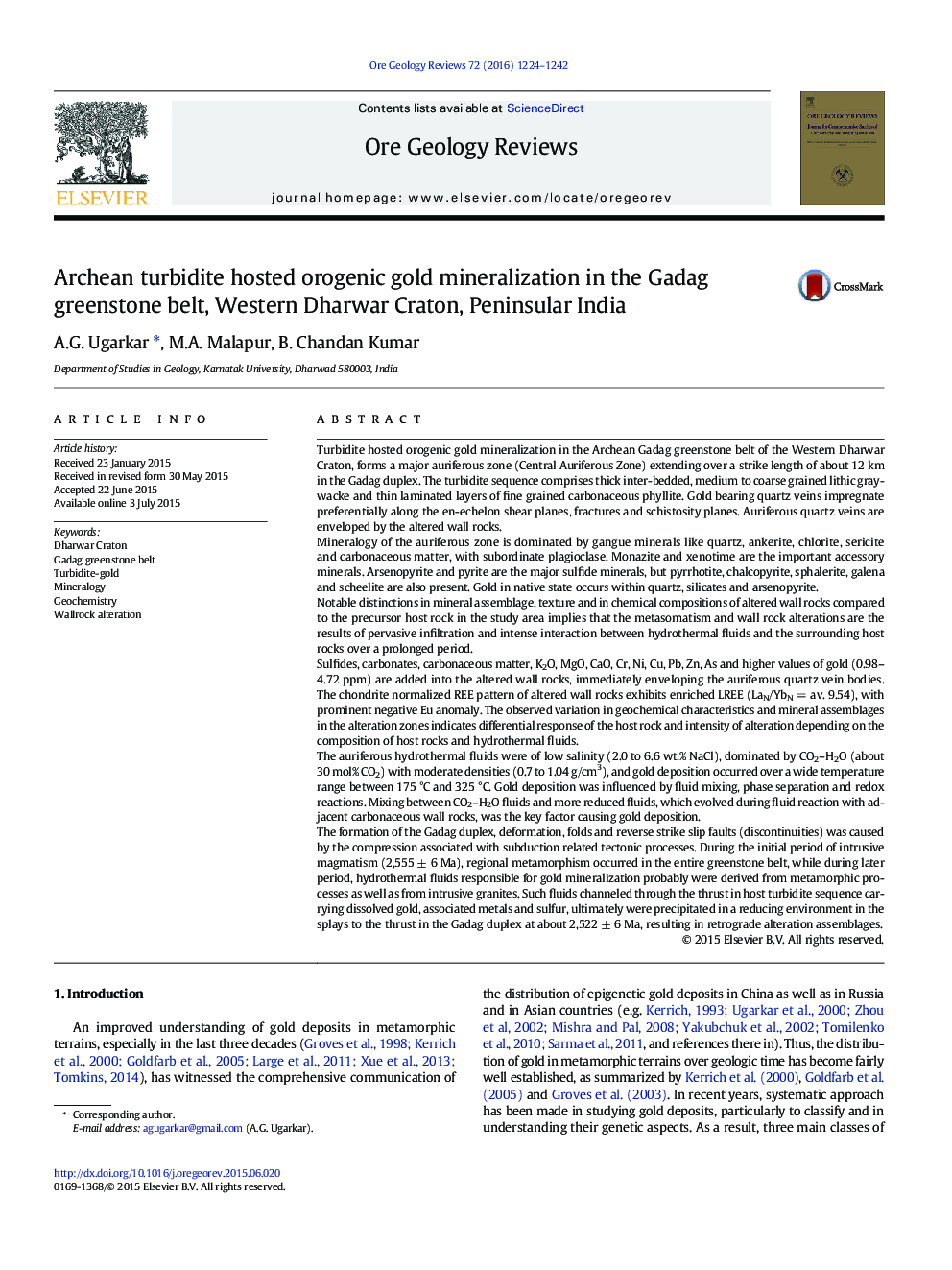| کد مقاله | کد نشریه | سال انتشار | مقاله انگلیسی | نسخه تمام متن |
|---|---|---|---|---|
| 4697236 | 1351867 | 2016 | 19 صفحه PDF | دانلود رایگان |

• Disusses turbidite hosted orogenic gold mineralization in Archean Gadag greenstone belt of Dharwar Craton, India.
• Gadag duplex and related structures were the results of compression due to subduction related tectonic processes.
• Mixing of CO2-H2O fluids and reduced fluids caused gold precipitation in a reducing environment in the Gadag duplex.
Turbidite hosted orogenic gold mineralization in the Archean Gadag greenstone belt of the Western Dharwar Craton, forms a major auriferous zone (Central Auriferous Zone) extending over a strike length of about 12 km in the Gadag duplex. The turbidite sequence comprises thick inter-bedded, medium to coarse grained lithic graywacke and thin laminated layers of fine grained carbonaceous phyllite. Gold bearing quartz veins impregnate preferentially along the en-echelon shear planes, fractures and schistosity planes. Auriferous quartz veins are enveloped by the altered wall rocks.Mineralogy of the auriferous zone is dominated by gangue minerals like quartz, ankerite, chlorite, sericite and carbonaceous matter, with subordinate plagioclase. Monazite and xenotime are the important accessory minerals. Arsenopyrite and pyrite are the major sulfide minerals, but pyrrhotite, chalcopyrite, sphalerite, galena and scheelite are also present. Gold in native state occurs within quartz, silicates and arsenopyrite.Notable distinctions in mineral assemblage, texture and in chemical compositions of altered wall rocks compared to the precursor host rock in the study area implies that the metasomatism and wall rock alterations are the results of pervasive infiltration and intense interaction between hydrothermal fluids and the surrounding host rocks over a prolonged period.Sulfides, carbonates, carbonaceous matter, K2O, MgO, CaO, Cr, Ni, Cu, Pb, Zn, As and higher values of gold (0.98–4.72 ppm) are added into the altered wall rocks, immediately enveloping the auriferous quartz vein bodies. The chondrite normalized REE pattern of altered wall rocks exhibits enriched LREE (LaN/YbN = av. 9.54), with prominent negative Eu anomaly. The observed variation in geochemical characteristics and mineral assemblages in the alteration zones indicates differential response of the host rock and intensity of alteration depending on the composition of host rocks and hydrothermal fluids.The auriferous hydrothermal fluids were of low salinity (2.0 to 6.6 wt.% NaCl), dominated by CO2–H2O (about 30 mol% CO2) with moderate densities (0.7 to 1.04 g/cm3), and gold deposition occurred over a wide temperature range between 175 °C and 325 °C. Gold deposition was influenced by fluid mixing, phase separation and redox reactions. Mixing between CO2–H2O fluids and more reduced fluids, which evolved during fluid reaction with adjacent carbonaceous wall rocks, was the key factor causing gold deposition.The formation of the Gadag duplex, deformation, folds and reverse strike slip faults (discontinuities) was caused by the compression associated with subduction related tectonic processes. During the initial period of intrusive magmatism (2,555 ± 6 Ma), regional metamorphism occurred in the entire greenstone belt, while during later period, hydrothermal fluids responsible for gold mineralization probably were derived from metamorphic processes as well as from intrusive granites. Such fluids channeled through the thrust in host turbidite sequence carrying dissolved gold, associated metals and sulfur, ultimately were precipitated in a reducing environment in the splays to the thrust in the Gadag duplex at about 2,522 ± 6 Ma, resulting in retrograde alteration assemblages.
Journal: Ore Geology Reviews - Volume 72, Part 2, January 2016, Pages 1224–1242